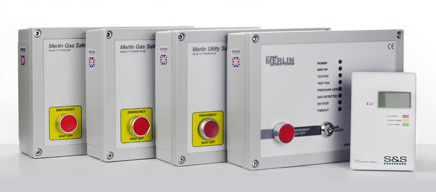S&S Northern has launched a comprehensive range of gas safety equipment for use in laboratories in UK schools, colleges and universities. The range consists of four gas pressure proving systems to meet all laboratory requirements, alongside a carbon dioxide detector which can be used in science and food technology laboratories and standard classrooms.
S&S Northern specialises in manufacturing and supplying gas pressure proving systems for use in the education sector, thousands of its systems have already been installed across the country. These systems offer a safe start-up and ensure teacher control, the safety and protection of students during the school day, and 24-hour building protection.
S&S Northern’s gas proving range for laboratories uses a single unique electronic pressure measuring system, which eliminates the issues associated with traditional ‘pressure switch’ systems and double transducer installations, making S&S Northern’s systems more reliable and easier and quicker to install.
The gas pressure proving range – safety for students and laboratories
The range includes:
• The Merlin 1000GD
• The Merlin 1000GD-plus
• Merlin 1000GDW
• The Merlin 1000GDW-plus
• The CO2 Detector
Each of S&S Northern’s gas pressure proving products offers distinct benefits to the education sector, such as:
Teacher control
All four of S&S Northern gas pressure units control the gas going to the benches in the laboratory so that if the key on the unit is turned to the ‘off’ position, the solenoid valve which normally allows gas into the laboratory is closed, ensuring that no gas can get into the laboratory. If no gas is being used during a lesson, the teacher can therefore leave the unit in the ‘off’ position, this prevents potential disruption to classes by students opening gas taps and allowing gas into the room. Although the gas tap on the bench can still open, there is no gas present to escape.
Protection of the building out of hours
Should there be a break in at the school with the intention of causing a fire, if the key is turned to ‘off’ during out of hours, S&S Northern’s gas pressure proving units will limit the damage which can be caused as there will be no gas present.
Additionally, the Merlin 1000GDW controls the water to the laboratory so having the keys in the ‘off’ position will isolate both the gas and the water services. The Merlin 1000GDW-plus isolates all three services as it controls the gas, water and bench electrics. Thus if the keys are in the ‘off’ position this can protect from flooding of the premises out of hours should there be a genuine leak or vandalism of pipe work.
Student safety
All four of S&S Northern’s gas pressure proving units will ensure student safety. The Merlin 1000GD ensures that the gas can be isolated if the key is turned to the off position, and with the Merlin 1000GD-plus both the gas going to the benches and the bench electrics can be isolated. The Merlin 1000GDW controls gas and water supply, and the Merlin 1000GDW-plus controls all three services – gas, water and bench electrics.
In the event of an emergency, the shut off button can be pressed on all four of these gas pressure proving units, and the gas valve closes immediately, protecting all those in the laboratory.
The CO2 Detector- ensuring a healthy classroom
The issue of good ventilation and reduced CO2 levels in classrooms is highlighted in IGEM/UP11 and Building Bulletin 101. S&S Northern’s CO2 detector helps meet these requirements with its ‘traffic light’ display showing teaching staff the level of CO2 in the room and therefore if action needs to be taken to increase ventilation.
Good air quality in schools helps improve students’ learning. In highly populated areas such as classrooms, students are breathing out large amounts of CO2, which can lead to drowsiness, lethargy and reduced concentration levels.
The detector’s green display indicates that the CO2 present is within recommended levels. If the level rises above 1000ppm the detector changes to Amber and the teacher should increase ventilation by turning on fans or opening doors or windows, in an effort to reduce the level. If the CO2 level goes above 1500ppm the CO2 detector changes to Red indicating an urgent need to increase ventilation.
In food technology classrooms where gas is present IGEM/UP/11 section 11.2 states that the average level of CO2 in the teaching area during the working day should not exceed 1500ppm and should never exceed 2800ppm of CO2 at any point throughout the teaching day. In food technology classrooms fitted with a gas interlock system, the gas valve will close and gas will be isolated if the CO2 level reaches 5000ppm.

